#costasiellidae
Text
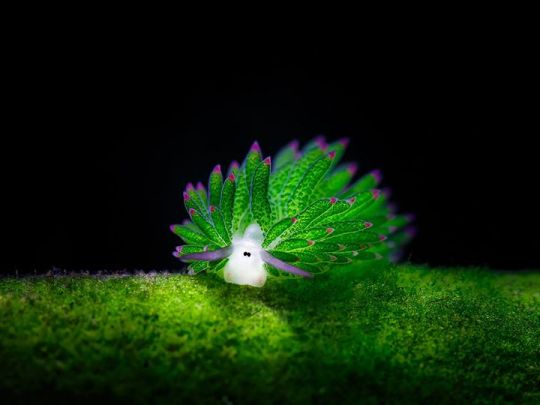
Green “Leaf Sheep” Sea Slugs (Costasiella kuroshimae), family Costasiellidae, found in coastal waters off of Indonesia, New Guinea and Japan
photograph by Jim & Lynn Photography
#costasiella#sea slug#costasiellidae#gastropod#mollusk#malacology#animals#nature#ocean#new guinea#asia
609 notes
·
View notes
Note
Hello! Love your blog. It's wonderful and is sure to make many people's days. Sea slug request: Cyerce Nigricans or Costasiella Kuroshimae.
🌊Latin name: Costasiella Kuroshimae
🌊Common name: Leaf slug, Leaf sheep, Solar-powered sea slug
🌊Family: Costasiellidae

🌐Near Japan, Indonesia, and the Philippines, leaf sheep can be found underwater, where light is available. Found next to coral reefs.

🦠They live and feed on Avrainvillea - a fuzy algea. They suck on the algea, getting the chloroplasts out and keep them in the ceratas for 10 days. This process is called kleptoplasty. It also means they can do photosyntesis - they’re one of the only sea creatures that can photosynthesize. If needed, it allows them to suppliment their diet in case of need.

More photos of these guys:
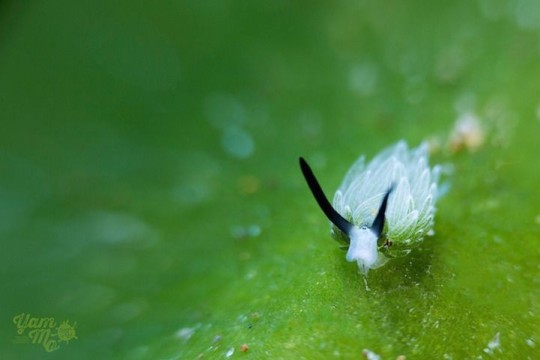
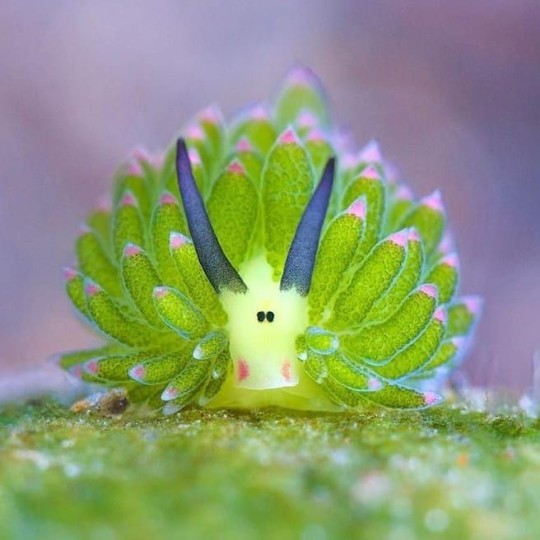

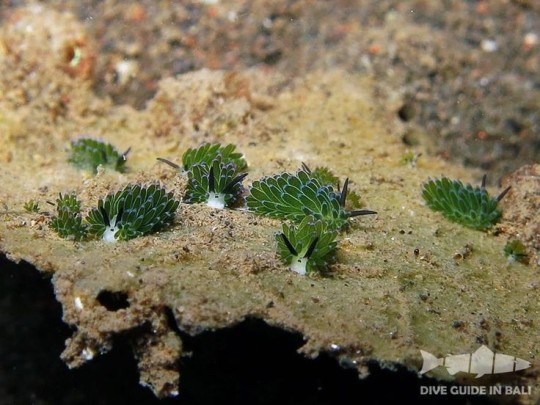
🐌 We thank you for the ask! Cyerce nigricans is for another time ;)
P.s: apologies for the late reply!
#answered ask#answered#ask#sea slug#seaslug haven#ocean#nature#deep sea#nudibranch#marine animals#marine life#Costasiella Kuroshimae#Costasiellidae#leaf slug#leaf sheep#solar-powered sea slug#most-definitively-a-human
87 notes
·
View notes
Text

Costasiella usagi
#Costasiella usagi#sea slug#Gastropoda#Heterobranchia#Opisthobranchia#Sacoglossa#Plakobranchacea#Limapontioidea#Costasiellidae#Costasiella#upl
9 notes
·
View notes
Photo

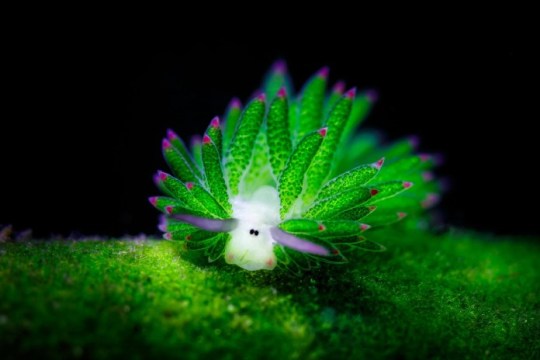
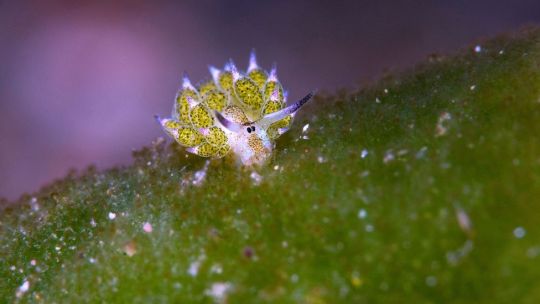
Costasiella kuroshimae (Leaf sheep, leaf slug)
Discovered in 1993 off the coast of the Japanese island Kuroshima. Leaf sheep are only about a fourth of an inch, or a little over 5 mm long.
Leaf sheep have rhinophores on their heads that look like the ears of a sheep in perspective to their faces. The leaf sheep’s rhinophores have fine hairs that sense chemicals in the water, enabling them to find food sources.
Leaf sheep’s primary diet is sea algae. When they consume it, they suck the chloroplasts out of the algae in a process called kleptoplasty. This process then enables them to photosynthesize. This is why leaf sheep glow. In other words, they are bioluminescent.
While some scientists believe that kleptoplasty can add to longevity in sacoglossans, the truth is – we don’t know how long leaf sheep live.
Because they are so beautiful and adorable, many people wonder if they can have a leaf sheep as a pet. But leaf sheep are still wild animals who have the right to live in their natural habitats.
1 note
·
View note
Text

Costasiella kuroshimae-also known as a "leaf slug", "leaf sheep", or "salty ocean caterpillar"-is a species of sacoglossan sea slug. Costasiella kuroshimae are shell- less marine opisthobranch gastropod mollusks in the family Costasiellidae. They range in size from 5 millimetres to 1 centimetre in length
📷:alexmustard1
Lembeh Strait
600 notes
·
View notes
Text
Meet the…

SEA SHEEP!
Costasiella kuroshimae, aka the leaf slug, sea sheep, and loads of other names, is a type of sacoglossan sea slug!
Scientific Classifications:
Kingdom: Animalia
Phylum: Mollusca
Class: Gastropoda
Clade: Heterobranchia
Informal Group: Opisthobranchia
Clade: Sacoglossa
Clade: Plakobranchacea
Superfamily: Limapontioidea
Family: Costasiellidae
Genus: Costasiella
These little cuties are around Japan, the Philippines, and Indonesia! They are capable of photosynthesis via a process called kleptoplasty, where they retain the chloroplasts from the algae they eat.
Their lifespan is between 6 months to a year. They are 5 millimeters to 1 centimeter
68 notes
·
View notes
Text
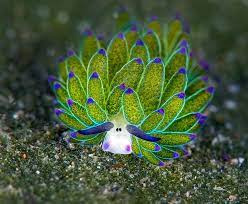
If you are looking for a new animal to admire, you might want to check out the leaf sheep, a species of sea slug that has some remarkable features. The leaf sheep, also known as Costasiella kuroshimae, is a tiny marine creature that lives in tropical waters near Japan, the Philippines, and Indonesia. It has a striking appearance, resembling a cartoon sheep with green leaves on its back. But what makes the leaf sheep even more fascinating is its ability to perform photosynthesis, a process usually reserved for plants.

The leaf sheep is a type of sea slug that feeds on algae. It belongs to the family Costasiellidae, which includes about 20 species of colorful slugs that have leaf-like protrusions on their backs. The leaf sheep was discovered in 1993 off the coast of the Japanese island Kuroshima and was named after its location. It can grow up to 1 centimeter in length and has two dark eyes and two rhinophores (sensory organs) that look like sheep's ears or insect antennae.
## How does the leaf sheep photosynthesize?
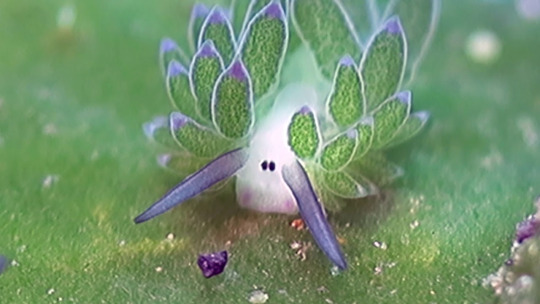

The leaf sheep is not only a cute and curious animal but also a valuable subject for scientific research. By studying how the leaf sheep manages to maintain the chloroplasts and photosynthesize, researchers can learn more about the evolution and adaptation of life forms, as well as the potential applications of biotechnology. For example, some scientists have suggested that the leaf sheep could inspire the development of artificial photosynthesis, which could help produce renewable energy and combat climate change
An interesting fact about them that made them the animal of the week.
We simply do not know how long they live. Some scientists argue that with photosynthesis, they must live to be very old, but we have no solid facts confirming or denying this theory. It fascinates me that with all the tools we have now for research, we do not know how long a small slug can live. In my closing words, I must point out that these species should not be kept as pets. We do not have enough knowledge about them to know how to treat them. I understand that this fact may be disappointing, but you can enjoy photos of them online to satisfy your adorable meter! And with that, I will see you next week with another animal of the week. Stay with Wonder!
8 notes
·
View notes
Text


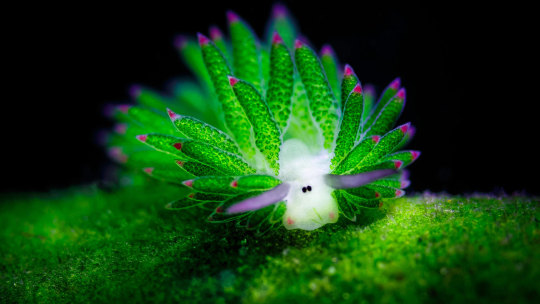
Leaf sheep!!!! Also known as Costasiella kuroshimae also known as a "leaf slug", "leaf sheep", or "salty ocean caterpillar"—is a species of sacoglossan sea slug.
Costasiella kuroshimae are shell-less marine opisthobranch gastropod mollusks in the family Costasiellidae. They range in size from 5 millimetres to 1 centimetre in length.
These sheep's diet is algae; the algae contains chlorophyll which is photosynthetic. This chemical from the algae they consume and the bodies of these nudibranchs has given them the name 'solar-powered sea slug' through photosynthesis.
──────────────────────
⇾ Follow my page for more epic, silly and boomblu content; share so I can grow if you wish, and come visit my other socials at my Linktree [Just click the word Linktree, it's hyperlinked :)]. ⇽
Check out the rest of my posts too!!! A lot of them are underrated. ;o Like everything you find interesting if you want. :3
Remember, you can find all of my socials here (click the word [here], it's hyperlinked (。◕‿‿◕。)
#nudibranch#nudibranchs#sea slugs#sea bunny#sea animals#sea life#sea creatures#sea#ocean#ocean life#oceancore#ocean view#underwater#water#cute animals#cute animal#animalia#animal#animals#cute lil guy#cute little guy#little guy#lil guy#just a little guy#just a lil guy#friend shaped#little man#smol#aesthetic#green aesthetic
18 notes
·
View notes
Text
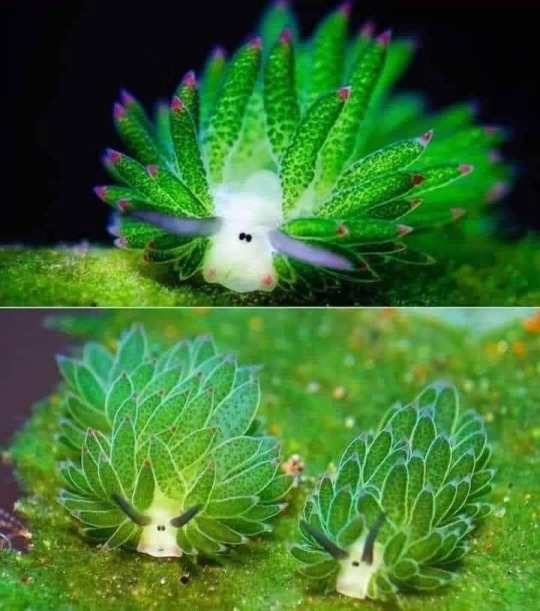
Costasiella kuroshimae—also known as a "leaf slug", "leaf sheep", or "salty ocean caterpillar"—is a species of sacoglossan sea slug. Costasiella kuroshimae are shell-less marine opisthobranch gastropod mollusks in the family Costasiellidae. They range in size from 5 millimetres to 1 centimetre in length.
The funny little creatures have the face of a cow or sheep, but a back that looks like a house plant.
They’re an animal that can Photosynthesize, and can be found in shallow marine waters in Japan, Indonesia and the Philippines.
They look like a farm animal, act like a plant, and live in the sea! 💚 how cool is that!? ✨🐮🐑🪴
7 notes
·
View notes
Note
Costasiella kuroshimae also known as a "leaf slug", or "leaf sheep" is a species of sacoglossan sea slug. Costasiella kuroshimae are shell-less marine opisthobranch gastropod mollusks in the family Costasiellidae. They range in size from 5 millimetres (0.20 in) to 1 centimetre (0.39 in) in length.

0 notes
Text

Costasiella kuroshimae aka leaf sheep/leaf slug
“Costasiella kuroshimae are shell-less marine opisthobranch gastropod mollusks in the family Costasiellidae.[3] They range in size from 5 millimetres (0.20 in) to 1 centimetre (0.39 in) in length.” -Wikipedia (I know LOL)
0 notes
Text

Green "Leaf Sheep" Sea Slugs (Costasiella kuroshimae), family Costasiellidae, Tulamben, Indonesia
photograph by Veeko Wang
#Costasiellidae#Costasiella#sea slug#nudibranch#gastropod#mollusk#malacology#ocean#animals#nature#asia
542 notes
·
View notes
Photo

Leaf Sheep ༼ つ ◕_◕ ༽つ 💖
32 notes
·
View notes
Text

Costasiella Kuroshimae "Leaf Sheep" or Leaf Slug. A species of sacoglossan Sea Slug. It's the only animal that can photosynthesize.
The funny little creatures have the face of a Cow or Sheep, but a back that looks like a house plant.
Discovered in 1993 off the coast of the Japanese island Kuroshima. Costasiella kuroshimae are shell-less marine opisthobranch gastropod mollusks in the family Costasiellidae. They range in size from 5 millimetres (0.20 in) to 1 centimetre (0.39 in) in length, and can be found in shallow marine waters in Japan, Indonesia and the Philippines.
They look like a farm animal, act like a plant, and live in the sea.... & they're cute af!
32 notes
·
View notes
Text

Sea Slug, Costasiella ocellifera, family Costasiellidae (Sarcoglossa), Caribbean Sea
Photograph by Mélodie Cts
50 notes
·
View notes